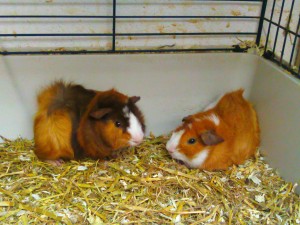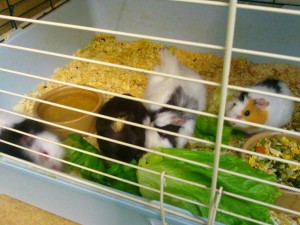Choosing Guinea Pig Cages
 So, you’ve decided to get a guinea pig or too and are wondering what type of cage you should get. But first, are you sure it’s a cage you want? Many guinea pigs live in hutches are are perfectly healthy and happy – there are no prooven reasons that a guinea pig cage is best for cages. In fact in my opinon hutches are better as they are (normally) made out of natural materials and the guinea pig will be in a more natural environment. It is best that a hutch be placed in an outbuilding or shed as this reduces the risk of predators hurting, scaring or killing your pets.
So, you’ve decided to get a guinea pig or too and are wondering what type of cage you should get. But first, are you sure it’s a cage you want? Many guinea pigs live in hutches are are perfectly healthy and happy – there are no prooven reasons that a guinea pig cage is best for cages. In fact in my opinon hutches are better as they are (normally) made out of natural materials and the guinea pig will be in a more natural environment. It is best that a hutch be placed in an outbuilding or shed as this reduces the risk of predators hurting, scaring or killing your pets.
Cages are a better option than hutches for those people that do not have the space for a hutch or people who don’t have a garden. Many owners, particularly in cities, house their guinea pigs in cages.
There are many different types of guinea pig cages; many of which are actually too small for guinea pigs. As a rule a guinea pig needs a minimum of 7.5 square feet of floor area in their house (cage or hutch). Also try not to exceed 10.5 square feet as guinea pigs have poor eye sight and don’t like large, open spaces.
Surprisingly many guinea pig cages that pet shops sell are actually too small – often the size of litter boxes; guinea pigs shouldn’t have to live in a litter box-sized area.
Guinea pigs also do not like being on their own, so you should get a cage that can accomodate more than one piggy.
Types of cages
One of the main types of cages that many owners use are the ‘standard cages’ – these are ones that hamsters are often housed in. A downfall of these is that they are often to small.
C&C cages are the other main type of cages. These cages are made up of several tray-like compartments with plastic or wire walls with interconnecting doors. These cages have no roof. C&C (Cubes and Coroplast cages) cages can have extra ‘rooms’ or compartments added on to give the guinea pig more space. Multiple storeys can be created too.
Whatever type of cage you get you should always carry out a safety check on it.
• Check for no sharp edges which the guinea pig could hurt him or herself on.
• All materials used should be guinea pig-friendly with no harmful chemicals.
• The floor should not be a wire mesh as guinea pigs can catch their legs and potentially break them which can be fatal.
• The cage should have good ventilation.
• Solid plastic or glass walls should be avoided as a build up of heat can incurr and the guinea pig could overheat.
 Privacy
Privacy
Most cages are ‘open’ ones where the guinea pig is constantly on show and can not get any privacy. You should always provide a guinea pig with some sort of place where he or she can hide; you can get especially made compartments to put in cages, or you can use cardboard boxes and tubes (these should have had no harmful chemicals in them at all).
Aside from a cage you’ll also need to have a place where your guinea pig can take regualr exercise – either a room (with no hazards) or an outdoor playpen. Guinea pigs should always be supervised when not in their cage.
 October 29, 2010
·
October 29, 2010
·  Maddia (Admin) ·
Maddia (Admin) ·  2 Comments
2 Comments
 Tags: C&C cages, guinea pig cages, guinea pigs · Posted in: Guinea Pig Care, Guinea Pig Information
Tags: C&C cages, guinea pig cages, guinea pigs · Posted in: Guinea Pig Care, Guinea Pig Information



2 Responses
You seem to have lots of great info on many different animals!
The only thing that needs tweaking is that you should NEVER have a store bought cage by itself. I have a C&C cage for my two guinea pigs. I had a store bought cage, and now use it as a litterbox, and half of it is a kitchen, with their food and water. A great websites specialized on guinea pigs with great information is guineapigcages.com ! I love your website!
The comment made by ‘Izzy’ makes no sense. I’ve housed pairs of my guinea-pigs in indoor cages, the largest measuring 3ft x 18″, two of my boars are housed in that one at the moment. It’s how you go about giving them exercise time that makes the difference. If the guinea-pig is sat in its bog standard sized cage (like my own) every single day with nowhere else to run around then it will get pretty bored and unhealthy. I have 10 guinea-pigs and 2 very large runs in my garden and I have to alternate who goes out and for how long every day. If you work out a routine for them either inside or outside then where they’re housed isn’t too much of a problem so long as its big enough they’re not crashing into things when they run around, cleaned out regularly enough and is in a safe part of the house. And that goes for hutches too.
But your statement is completely correct, there are far too many places selling cages/hutches which are so small I wouldn’t even house a pair of hamsters in them! I know a couple of places like that in my local town and do they listen? Nope.
I’ve only seen this page so far but it looks good. Very informative.